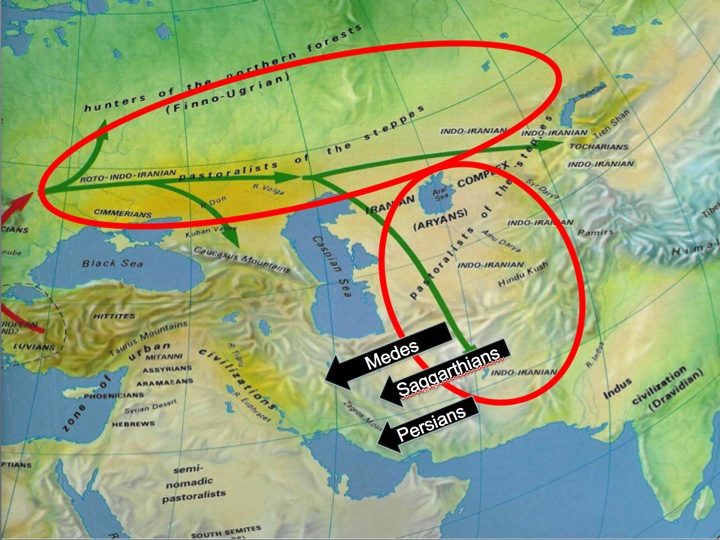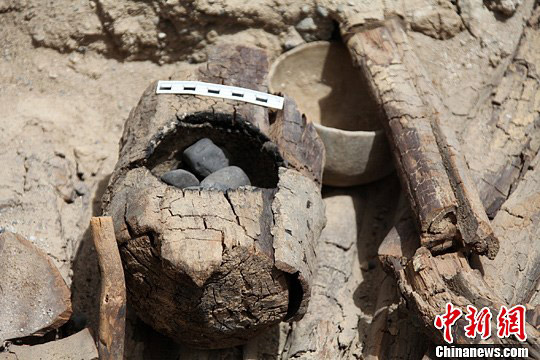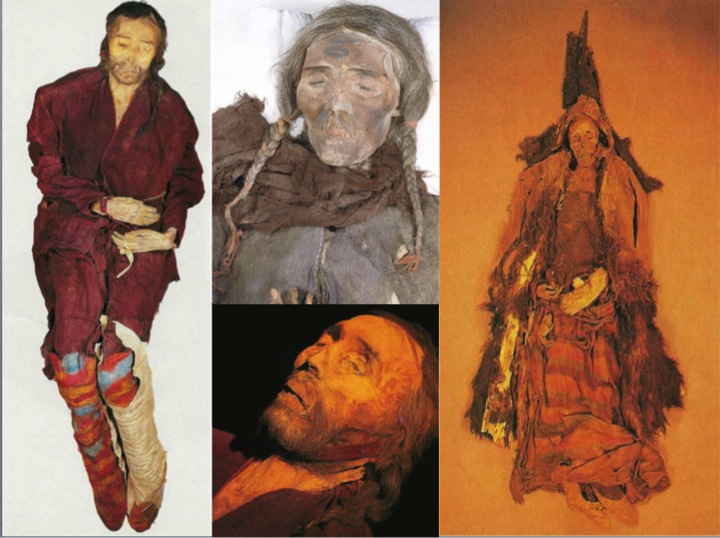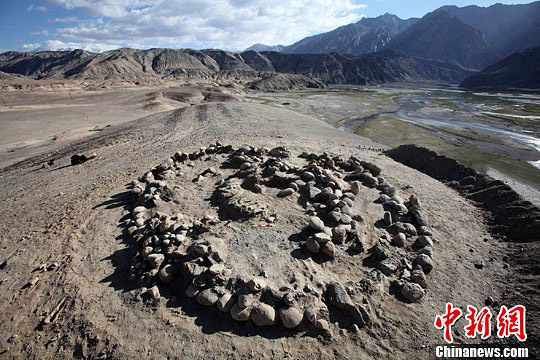The article below entitled “Excavation ‘very likely’ to redefine the Zoroastrianism’s origin” was published on August 12, 2014 by China’s CCTV network.
Three important notes the CCTV article fails to mention that:
- Iranian-speaking Persians, Medes, Saggarthians, Parthians, etc. themselves came onto the Iranian plateau from the Central Asian steppes, areas adjacent to the Pamir and northwest China regions. Those regions themselves were inhabited with Iranian speaking and fellow Indo-European Tocharian (or possibly proto-Celtic) peoples. These peoples were to be largely displaced by the later arrival of proto-Turkic and Hunnic peoples.
- It has been speculated for decades that proto-Zoroastrianism may have originated in the Central Asian regions and then bought to the Iranian plateau by Iranian speakers over 2500 years ago. Thus the title of the report “Excavation ‘very likely’ to redefine the Zoroastrianism’s origin” is somewhat sensationalist (if not misleading) as ancient Persia was itself part of a larger Iranic-civilization connected to Central Asia and much of Eastern Europe (through the Iranic-speaking Scythians and later Sarmatians).
- Several well-preserved mummies bearing Caucasoid features have been uncovered in northwest China (see pictures below) dated to the timelines of 2500 years past and older. The mummies bear clothing, headgear consistent with the dress of the ancient Medes, Persians, Parthians and Scythians-Saka (of Central Asia and ancient Russia-Ukraine).
Kindly note:
- The first and third pictures (and accompanying captions) inserted into the article are from Kaveh Farrokh’s lectures at the University of British Columbia’s Continuing Studies Division.
- The second and fourth pictures (and accompanying captions) are from China’s CCTV article.
============================
Zoroastrianism was the state religion of the ancient Persian Empire. Its founder, Zoroaster, or Zarathustra, is thought to have been born in what is now Northeast Iran or Southwest Afghanistan. A 2004 survey by the Zoroastrian Associations of North America put the estimated number of believers worldwide at between 124,000 and 190,000.
 Basic diagram outlining arrival of Iranian speaking peoples (Medes, Persians, Saggarthians) onto the Iranian plateau before the formation of the first Medo-Persian or Achaemenid Empire in 550-330 BCE. The red elliptical markings provide approximate areas where Iranian speaking peoples were located thousands of years ago. The diagram does not show the arrival of several other Iranian peoples such as the Parthians and other Saka peoples from Central Asia or the subsequent arrival of the Alans into northwest Iran in 75 CE (Source: Kaveh Farrokh’s lectures at the University of British Columbia’s Continuing Studies Division – this was also presented at Stanford University’s WAIS 2006 Critical World Problems Conference Presentations on July 30-31, 2006, the annual Tirgan event at Toronto (June, 2013) and at Yerevan State University’s Iranian Studies Department (November, 2013) – Diagram is Copyright of University of British Columbia and Kaveh Farrokh).
Basic diagram outlining arrival of Iranian speaking peoples (Medes, Persians, Saggarthians) onto the Iranian plateau before the formation of the first Medo-Persian or Achaemenid Empire in 550-330 BCE. The red elliptical markings provide approximate areas where Iranian speaking peoples were located thousands of years ago. The diagram does not show the arrival of several other Iranian peoples such as the Parthians and other Saka peoples from Central Asia or the subsequent arrival of the Alans into northwest Iran in 75 CE (Source: Kaveh Farrokh’s lectures at the University of British Columbia’s Continuing Studies Division – this was also presented at Stanford University’s WAIS 2006 Critical World Problems Conference Presentations on July 30-31, 2006, the annual Tirgan event at Toronto (June, 2013) and at Yerevan State University’s Iranian Studies Department (November, 2013) – Diagram is Copyright of University of British Columbia and Kaveh Farrokh).
Now, archaeologists in Northwest China’s Xinjiang Uygur Autonomous Region have discovered major Zoroastrian tombs, dated to over 2,500 years ago. This unravelling is leading to startling controversial speculation about the religion’s origin.
On China’s sparsely populated Pamir Plateau, ancient people lived and battled, and created a marvelous civilization. These massive tombs, now being excavated, are the world’s earliest traces of the religion of Zoroastrianism found so far.
Zoroastrianism took form even before the rise of Persian Empire, which later adopted it as the state religion. The sun and fire are central to the religion, and the signs are found everywhere in the tombs.
 Archaeologists in Northwest China’s Xinjiang Uygur Autonomous Region have discovered major Zoroastrian tombs, dated to over 2,500 years ago. (Caption and Photo Source: Chinanews.com). As noted in the China News report: “This is a typical wooden brazier found in the tombs. Zoroastrians would bury a burning brazier with the dead to show their worship of fire. The culture is unique to Zoroastrianism…This polished stoneware found in the tombs is an eyebrow pencil used by ordinary ladies. It does not just show the sophistication of craftsmanship here over 2,500 years ago, but also demonstrates the ancestors’ pursuit of beauty, creativity and better life, not just survival. It shows this place used to be highly civilized”.
Archaeologists in Northwest China’s Xinjiang Uygur Autonomous Region have discovered major Zoroastrian tombs, dated to over 2,500 years ago. (Caption and Photo Source: Chinanews.com). As noted in the China News report: “This is a typical wooden brazier found in the tombs. Zoroastrians would bury a burning brazier with the dead to show their worship of fire. The culture is unique to Zoroastrianism…This polished stoneware found in the tombs is an eyebrow pencil used by ordinary ladies. It does not just show the sophistication of craftsmanship here over 2,500 years ago, but also demonstrates the ancestors’ pursuit of beauty, creativity and better life, not just survival. It shows this place used to be highly civilized”.
Today, most of the ancient glories lie in ruins. But the dig now offers a glimpse of what life here looked like over 25 centuries ago.
 Mummies bearing Caucasoid features uncovered in modern northwest China; these were either Iranic-speaking or fellow Indo-European Tocharian (proto-Celtic?). Archaeologists have found burials with similar Caucasoid peoples in ancient Eastern Europe. Much of the colors and clothing of the above mummies bear striking resemblance to the ancient dress of pre-Islamic Persia/Iran and modern-day Iranian speaking tribal and nomadic peoples seen among Kurds, Lurs, Persians, etc. (Source: Kaveh Farrokh’s lectures at the University of British Columbia’s Continuing Studies Division – this was also presented at Stanford University’s WAIS 2006 Critical World Problems Conference Presentations on July 30-31, 2006, the annual Tirgan event at Toronto (June, 2013) and at Yerevan State University’s Iranian Studies Department (November, 2013) – Diagram is Copyright of University of British Columbia and Kaveh Farrokh).
Mummies bearing Caucasoid features uncovered in modern northwest China; these were either Iranic-speaking or fellow Indo-European Tocharian (proto-Celtic?). Archaeologists have found burials with similar Caucasoid peoples in ancient Eastern Europe. Much of the colors and clothing of the above mummies bear striking resemblance to the ancient dress of pre-Islamic Persia/Iran and modern-day Iranian speaking tribal and nomadic peoples seen among Kurds, Lurs, Persians, etc. (Source: Kaveh Farrokh’s lectures at the University of British Columbia’s Continuing Studies Division – this was also presented at Stanford University’s WAIS 2006 Critical World Problems Conference Presentations on July 30-31, 2006, the annual Tirgan event at Toronto (June, 2013) and at Yerevan State University’s Iranian Studies Department (November, 2013) – Diagram is Copyright of University of British Columbia and Kaveh Farrokh).
This is the biggest excavation of the tombs of Zoroastrianism here in Xinjiang’s history. Some archaeologists say the excavation is likely to prove that this religion is originated from the Pamir Plateau, right here beneath of our feet.
 Archaeologists in Northwest China’s Xinjiang Uygur Autonomous Region have discovered major Zoroastrian tombs, dated to over 2,500 years ago. (Caption and Photo Source: Chinanews.com). As noted in the China News report: “All the evidence leads to one conclusion: Zoroastrianism originated in the east on China’s Pamir Plateau. To this day, archaeologists are still arguing over where the religion originated, but here, we have found the earliest and the largest scale of Zoroastrian ruins, with all the typical symbols of this religion. Of course, there’s the possibility that there are other undiscovered ruins elsewhere in the world. But at this moment, it’s a logical conclusion that the origin of the religion is here, not in Persia.” said Wu Xinhua, Xinjiang Director, Archaeological Inst., Chinese Academy of Social Sciences.
Archaeologists in Northwest China’s Xinjiang Uygur Autonomous Region have discovered major Zoroastrian tombs, dated to over 2,500 years ago. (Caption and Photo Source: Chinanews.com). As noted in the China News report: “All the evidence leads to one conclusion: Zoroastrianism originated in the east on China’s Pamir Plateau. To this day, archaeologists are still arguing over where the religion originated, but here, we have found the earliest and the largest scale of Zoroastrian ruins, with all the typical symbols of this religion. Of course, there’s the possibility that there are other undiscovered ruins elsewhere in the world. But at this moment, it’s a logical conclusion that the origin of the religion is here, not in Persia.” said Wu Xinhua, Xinjiang Director, Archaeological Inst., Chinese Academy of Social Sciences.
Logical, perhaps. Startling and controversial, certainly. And as the excavation continues, the Pamir Plateau is bound to yield more amazing discoveries.



